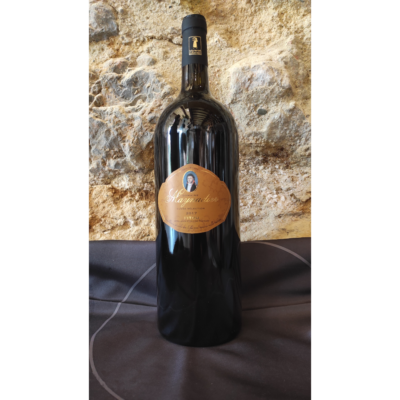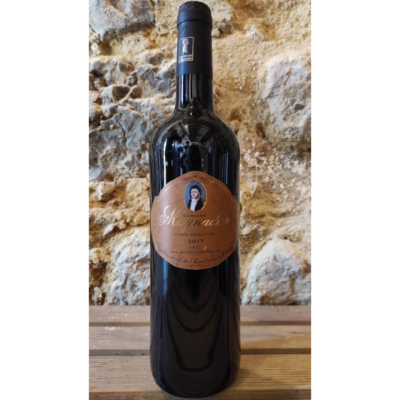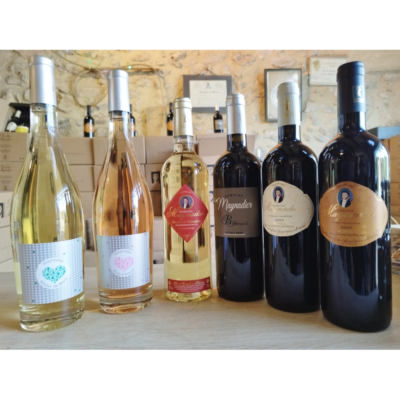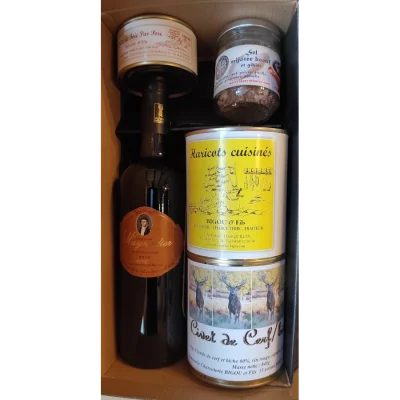The Languedoc vineyards extend over four departments of the Occitanie region: Gard, Pyrénées Orientales, Aude and Hérault. All types of wine are produced here, and have been for a long time: reds, rosés and still whites, sparkling wines, but also natural sweet wines.
Geographical location
The Languedoc is one of the southernmost regions of France. The AOC Languedoc is an extension of the Coteaux du Languedoc appellation – recognised as an AOC in 1985 – which extends from the Spanish region to Nîmes, via the Camargue and the Gulf of Lion.
The southern part begins at the foot of the Montagne Noire and ends in the east at the foot of the Cévennes. This is the part covered by the garrigue which alternates between hillsides, ridges and plateaux.
The Corbières massif on the other side stretches from Carcassonne to the ponds of Leucate and La Nouvelle, from the sub-Pyrenean hills of Limouxin and Malpère. The vineyards face the Mediterranean.
The Roussillon vineyards are located in the Pyrénées Orientales department, in the continuation of the Languedoc vineyards, from the Etang de Leucate to the Spanish border.
It is bordered to the north by the Corbières massif, to the west by the Canigou massif, to the south by the Albères massif and to the east by the Mediterranean Sea.

History
The Greeks and Etruscans were the first to plant vines six centuries before Christ. They had already mastered wine making and immediately understood that the soil and climatic conditions were favourable to viticulture.
As wars and conquests progressed, the region came under the control of the Romans, who were equally keen on wine and outstanding merchants. Thanks to the writings of Pliny, Cicero and Columella, we learn that the wines of Narbonnaise – the name of the region at the time – were destined for export to Greece, Egypt, Turkey and Rome. The amphorae made in Béziers were used to store and transport the wine.
The Narbonnaise lost its unity, the vines were abandoned when they were not destroyed. As time went by, religions also changed, and “thanks to God”, the church took a close interest in wine, not so much to drink it as to take advantage of the wealth and power it could provide. The vines are once again given pride of place.
From the 8th century onwards, the church built abbeys and monasteries which ruled over a prosperous vineyard. It even integrated the science of the vine into its teaching. Unfortunately, the arrival of the Muslims and with them leprosy sounded the end of viticulture.
It was not until 1432 and Jacques Cœur that commercial activity was revived, bringing back the vineyards to supply the ships sailing to Alexandria where the wines were exchanged for spices, aromatics and gold. In 1680, the inauguration of the Canal du Midi opened up trade on the route to the Atlantic.

In 1729, the first regional organisation of wine production in France was created. A decree signed by the king at the request of the Languedoc states imposed a mark to be affixed to the bottom of the barrels to attest to the origin of the wine and its method of production.
In the 19th century, the industrial revolution and the railway made it easier to distribute wine to the northern parts of the country.
At the end of the 19th century, the Languedoc vines were devastated by phylloxera and it would take time to rebuild them. Paul Coste Loret initiated a new quality policy that recognised the Languedoc terroirs from 1945. They were decreed VDQS – Vin Délimité de Qualité Supérieure – even before the AOCs were created.
During the 1950s, Languedoc wines had a reputation for mediocrity and much work was undertaken to improve their quality. During the 1970s, Languedoc viticulture completely reorganised the distribution of its vines, eliminating the highly productive but poor quality vines in favour of those with higher virtues.
This very long work is bearing fruit, both literally and figuratively, with the acquisition in 2007 of the AOC Languedoc, at last!

Climate
The climate is mainly Mediterranean with very hot and dry summers and mild winters with temperatures rarely falling below zero. Only the omnipresent Tramontane wind cools down the winters, but it is praised by the winegrowers for its beneficial effect on the vines: in hot weather, it cools them down by bringing humidity from the sea and, in winter, it shakes the bunches and dries them, thus protecting them from diseases.
Rainfall is one of the lowest in France and only the recurrent violent storms upset this low curve.
Geology
The soils of Languedoc Roussillon are very diverse and offer a variety of compositions with clay, sand, pudding, basalt, limestone, shale, sandstone, marl…
AOC Languedoc
Within the 531 communes that make up the AOC Languedoc, the grapes must come from precise plots – parcel delimitation – that meet terroir criteria.
The terroir specifications
The specifications of the AOC Languedoc are established in the decree of 29 October 2009:
- Grape varieties: the wine must be made from at least two grape varieties. It is these blends that give great complexity to the wines.
For the reds and rosés: grenache noir, syrah and mourvèdre (50% minimum), alongside cinsault and carignan noir.
For the whites: white grenache, white clairette, bourboulenc, white piquepoul, roussanne, marsanne, rolle and tourbat (70% minimum for all 8 varieties), alongside white carignan, white terret, white ugni, maccabeu and 10% maximum viognier.
- The alcoholic strength must be higher than 11.5%.
- Vineyard management: short pruning, with a maximum of twelve free eyes per stock.
- The maximum yield is 50 hectolitres per hectare for red and rosé wines and 60 hectolitres for white wines. The average yield is 45 hectolitres per hectare.
- The minimum density is 4,000 vines per hectare and some winegrowers prefer to plant more than 5,000 vines per hectare to achieve a lower load per vine.
- The vinification of the red wines is mostly traditional, but some vintages may be made with whole grain vinification and carbonic maceration.
The white wines are vinified by direct pressing, as is the case for the rosé wines, but they can also be made by bleeding.
Temperatures are controlled from the beginning of fermentation to the end of maturation.
The particularities of the Languedoc
The red wines of the AOC Languedoc have a lively, deep colour. The dominant aromas, linked to the Mediterranean terroir, should offer notes of red fruit, spices and garrigue.
The wine is structured and the fine tannins are present but still with a certain roundness.
In gastronomy, we recommend Languedoc red with grilled meats, game and cheese.
The rosé wine from the Languedoc appellation has a deep pink colour with aromas of fresh fruit. They are generally associated with charcuterie, country meals and summer aperitifs.
The white wines of the AOC Languedoc have a light yellow color and their aromas are reminiscent of white peach blossoms, citrus and fruits such as pear.
In gastronomy, they are often combined with fish and seafood.

The grape varieties of the Languedoc
The most representative of the Mediterranean region: carignan, grenache noir, syrah, mourvèdre, cinsault, morastel, picpoul noir and terret noir for red and rosé wines; white carignan, grenache blanc, maccabeu, bourboulenc, marsanne, roussanne, piquepoul blanc, clairette blanche, rolle, tourbat and viognier for the white wine
AOC Roussillon
The Roussillon produces dry still wines and natural sweet wines. They are divided into sub-regional and communal appellations.
With 14 AOC/AOP and 3 VDP/IGP, mainly from 25 different grape varieties, the wines of Roussillon are very rich, each expressing its own character.
Dry wines, AOC/AOP: Collioure (white, rosé, red), Côtes du Roussillon (white, rosé, red), Côtes du Roussillon Villages (red), Côtes du Roussillon Villages Caramany, Côtes du Roussillon Villages Latour de France, Côtes du Roussillon Villages Lesquerde, Côtes du Roussillon Villages Tautavel, Côtes du Roussillon Villages Les Aspres, Maury sec (red).
The VDP/IGP are: IGP des Côtes Catalanes (white, rosé, red), IGP de la Côte Vermeille (white, rosé, red), IGP d’Oc (white, rosé, red).
In Vins Doux Naturels, the AOC/AOP are : Rivesaltes (Amber, Garnet, Tuilé, Rosé, Hors d’Age, Rancio), Maury (White, Amber, Garnet, Tuilé, Hors d’Age, Rancio), Banyuls (White, Rosé, Rimage, Amber, Tuilé, Hors d’Age, Rancio), Banyuls Grand Cru Muscat de Rivesaltes.
The grape varieties of Roussillon
The Roussillon grape varieties are wines made from a blend of main, complementary grape varieties.
The main grape varieties: muscat à petits grains, muscat d’Alexandrie, grenache noir, grenache blanc, grenache gris, macabeu, tourbat or malvoisie du Roussillon, syrah, mourvèdre, lledoner pelut, carignan.




